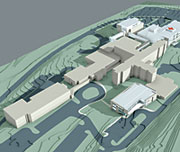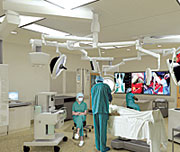The New Age of High-Tech Hospitals
Converging bricks and mortar
Convergence translates to health-care architecture mostly through the centralization of these systems in massive new data centers, as well as the proliferation of smaller closets to handle wireless devices or critical components that cannot be housed with other systems. Consider that instead of three antennae in the corridor ceiling for different systems, one antenna feeds back to an IT closet where each system's control unit would be mounted in an equipment rack. With each additional system, more rack space is needed, and IT closets get larger. This situation, as well as how all of these IT considerations affect the operational procedures of the hospital, explains why consultants like RTKL's Sanchez argue for their early involvement in design. The tendency of architects in planning the building to use out-dated grossing factors-standardized area-allocation percentages-which affect square footage for IT space, only exacerbates the problem.
Â
|
|||||||||
Â
For example, take the PACS system, which is basically a digital X-ray, or could be something like magnetic resonance imaging (MRI) results. Doctors and radiologists use these images to diagnose a patient. A doctor may want to review that information at the patient's bedside, in an OR, or on a golf course, so the IT system must accommodate compression formats that support moving this data between everything from large-screen monitors to handheld personal digital assistants (PDAs). If the IT consultant can't establish these hospital operational needs early on, adding equipment racks at the end of the construction document phase may prove impossible. This is the sort of "planning" that leads to IT rooms in converted janitor's closets.
"The rate of change on the technology side complicates
long-range planning," says Jim Crispino, AIA, president of the Philadelphia-based firm Francis Cauffman, "but you just have to build that space into your infrastructure." Crispino, who leads his firm's health-care design from its New York office, feels that health care is in a technology transition, where old systems like light boxes for X-rays are still required, even when hospitals have adopted digital formats.
The penchant for building flexible shell space, particularly for new hospitals, can often lead to complications, he says, because while a hospital may agree to build 500 square feet of shell space for a future CT scan room, they may not agree to build 50 square feet for an IT closet to support it. "We have to understand that these things have a physical presence, and because of that very simple fact, how they are configured and where they reside needs to be coordinated by the architect," Crispino says. If you ask many IT consultants whether most architects understand what Crispino is saying, you're likely to hear a resounding no. But that is changing as more health-care clients have recognized how poor decisions about technology infrastructure can haunt their buildings for years to come. By 2009, it's expected that a new version of the National Fire Protection Agency's Standard for Health Care Facilities (NFPA 99) will codify things such as IT room sizes, basically forcing the issue on architects.
Â













